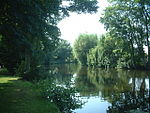Whitlingham railway station
Disused railway stations in NorfolkEast of England railway station stubsFormer Great Eastern Railway stationsPages with no open date in Infobox stationRailway stations in Great Britain closed in 1955 ... and 2 more
Railway stations in Great Britain opened in 1874Use British English from March 2017

Whitlingham was a station in Whitlingham, Norfolk. The simple station has been demolished leaving no trace of its existence. However the footbridge is still in use for pedestrian use. Just east (away from Norwich and not in the photo) of the footbridge is the junction where services to Sheringham split from services to Lowestoft and Great Yarmouth. Former Services
Excerpt from the Wikipedia article Whitlingham railway station (License: CC BY-SA 3.0, Authors, Images).Whitlingham railway station
Whitlingham Lane, Broadland Thorpe St Andrew
Geographical coordinates (GPS) Address Website Nearby Places Show on map
Geographical coordinates (GPS)
| Latitude | Longitude |
|---|---|
| N 52.6254 ° | E 1.3477 ° |
Address
NWT Thorpe Marshes
Whitlingham Lane
NR7 0QA Broadland, Thorpe St Andrew
England, United Kingdom
Open on Google Maps










